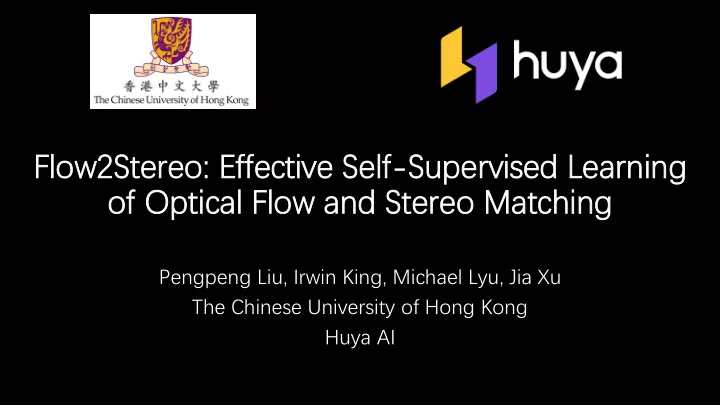

Flo low2Stereo: w2Stereo: Eff ffective ective Se Self lf-Sup Supervised ervised Lea earning rning of Op f Optical ical Flo low w an and St Ster ereo eo Matc atching hing Pengpeng Liu, Irwin King, Michael Lyu, Jia Xu The Chinese University of Hong Kong Huya AI
We propose a unified method to jointly learn optical flow and stereo matching. ➢ Intuition 1: stereo matching can be modeled as a special case of optical flow, and we can leverage 3D geometric constraints behind stereoscopic videos to guide the learning of these two forms of correspondences. ➢ Intuition 2: we unveil the bottlenecks in prior self-supervised learning approaches and propose to create a new set of challenging proxy tasks to boost performance.
Geometric relationship between flow and stereo 12 cross-view correspondnce maps among 4 stereoscopic frames. 3D geometric constraints between optical flow 𝐱 𝑚 and 𝐱 𝑠 ) and stereo disparity from time 𝑢 to 𝑢 + 1 in the 3D projection view.
Self-Supervised Learning: stage 1 Stage 1: we add geometric constraints between optical flow and stereo disparity to improve the quality of confident predictions.
Self-Supervised Learning: stage 2 Stage 2: we create challenging proxy tasks to guide the student model for effective self-supervised learning.
Our method outperforms all existing unsupervised optical flow methods on KITTI datasets. Our self-supervised method even outperforms several state-of-the-art fully supervised methods.
We directly apply our optical flow model to estimate stereo disparity, it achieves state-of-the-art unsupervised stereo matching performance.
Optic Optical al flow flow qual qualitati itative ve evaluati evaluation on: our model achieves much better results both quantitatively and qualitatively (e.g., shaded boundary regions). For each case, the top row is optical flow and the bottom row is error map. Lower Fl is better.
Stereo Stereo matchin atching qual qualitative tative evalua evaluation ion: Our models estimate more accurate disparity maps (e.g., image boundary regions and moving-object boundary regions) For each case, the top row is stereo disparity and the bottom row is error map. Lower D1 is better.
Conclusion ➢ We have presented a method to jointly learning optical flow and stereo matching with a unified model. ➢ We show that geometric constraints can improve the quality of those confident predictions. ➢ we unveil the bottlenecks in prior self-supervised learning approaches and propose to create a new set of challenging proxy tasks to boost performance. ➢ Code available: https://github.com/ppliuboy/Flow2Stereo
Recommend
More recommend